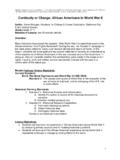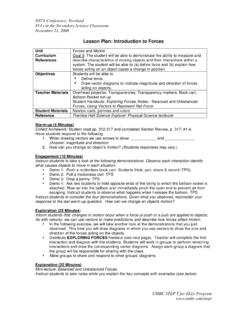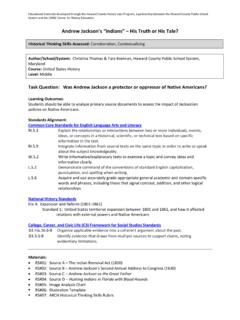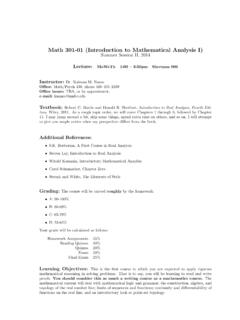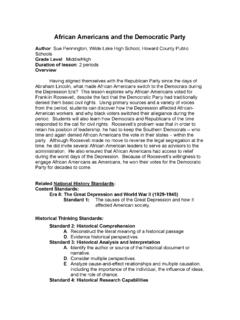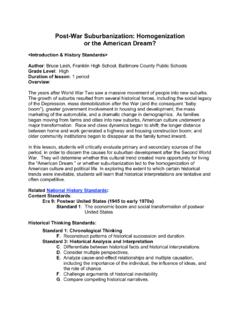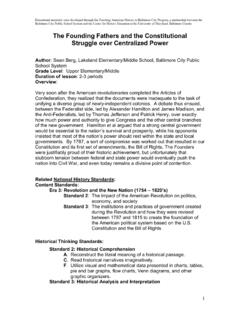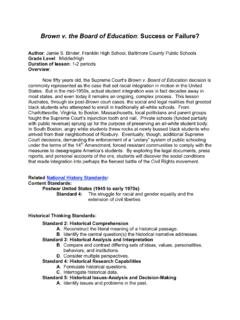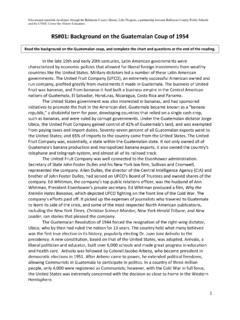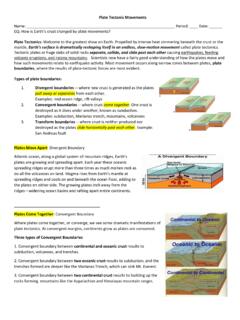Transcription of Shays’ Rebellion - University of Maryland, Baltimore County
1 Educational materials developed through the Howard County History Labs Program, a partnership between the Howard County Public School System and the UMBC Center for History Education. Shays Rebellion Historical Thinking Skills Assessed: Close Reading, Corroboration Author/School/System: Megan Brown and Ronald Bianchi, Howard County Public School System, Maryland Course: United States History Level: Upper Elementary/Middle Task Question: How did the leaders of the American Revolution view Shays Rebellion ? Learning Outcome: Students will be able to read closely and corroborate multiple primary sources to draw conclusions about the founding fathers views of Shays Rebellion . Standards Alignment: Common Core Standards for English Language Arts and Literacy National History Standards Era 3: Revolution and the New Nation Standard 3: The institutions and practices of government created during the Revolution and how they were revised between 1787 and 1815 to create the foundation of the American political system based on the Constitution and the Bill of Rights.
2 College, Career, and Civic Life (C3) Framework for Social Studies Standards Explain why individuals and groups during the same historical period differed in their perspectives. Use evidence to develop a claim about the past. Materials: RS#01: Shays Rebellion Article RS#02: Shays Rebellion Note-taking Sheet RS#03: Document A Excerpts of Letters Written by George Washington in Response to Shays Rebellion Quote accurately from a text when explaining what the text says explicitly and when drawing inferences from the text. Determine two or more ideas of a text and explain how they are supported by key details; summarize the text. Analyze multiple accounts of the same event or topic, noting important similarities and differences in the point of view they represent.
3 Write opinion pieces on topics or texts, supporting a point of view with reasons and information. Introduce a topic or text clearly, state an opinion, and create an organizational structure in which ideas are logically grouped to support the writer s purpose. Educational materials developed through the Howard County History Labs Program, a partnership between the Howard County Public School System and the UMBC Center for History Education. RS#04: Document B Excerpts of Letters Written by Thomas Jefferson in Response to Shays Rebellion RS#05: Shays Rebellion Note-taking Sheet (SAMPLE) RS#06: Thoughtful Application: Newspaper Article RS#06A: Newspaper Article Worksheet RS#07: ARCH Elementary Historical Thinking Skills Rubric Close Reading/Corroboration Background for the Teacher: In the summer of 1786, only three years after the end of the Revolutionary War, Shays Rebellion began in Massachusetts.
4 Merchants who had lent money to the Continental Congress to fund the Revolution began to call in their debts and insist upon payment in cash for future goods and services. The credit of the young United States was in jeopardy. With no authority under the Articles of Confederation to collect taxes or regulate trade, the federal government was forced to rely on the states to repay their own foreign debts and pay for their own portion of the enormous war debt. States raised taxes dramatically in order to meet their obligations. Meanwhile, farmers throughout the country, many of whom were Revolutionary War veterans who had never been paid fully for their services, were struggling with their own financial hardships in the depressed post-war economy.
5 They did not have the cash to pay the taxes, but the state governments were unsympathetic. Debt collectors took people to court for their inability to pay their taxes. Many individuals lost their land and property, and many petitioned the government for debtor relief, which they did not receive. In August 1786, a group of 1,500 farmers in western Massachusetts, led by Revolutionary War veteran Daniel Shays, began an uprising to protest what they believed were unfair land taxes and an unresponsive government. During the fall and winter, they marched on the debtors courts, forcing them to postpone business. To restore order, a group of merchants from eastern Massachusetts funded a militia to pursue the rebels.
6 In January 1787, Shay and his followers attempted to capture the weapons stored in a federal arsenal but were stopped by the militia, who opened fire. The rebels scattered but were pursued by the militia. Finally, in February, the resistance ended. The militia had captured most of the men, although they were eventually pardoned, including Shays. In order for students to be successful with this performance assessment task, they must have a prior understanding of the colonists justifications for the American Revolution, the roles of George Washington and Thomas Jefferson as leaders of the Revolution, the provisions of the Articles of Confederation, and the challenges facing the young nation. In addition, it is critical that students firmly grasp the circumstances surrounding Shays Rebellion before moving onto the analysis of the primary sources.
7 Procedure Context Setting: Distribute RS#01: Shays Rebellion Article and RS#02: Shays Rebellion Note-taking Sheet. Tell students that the purpose for reading is to summarize Shays Rebellion . Students should preview the questions before reading, read the text independently, and then highlight the answers or take notes in the margins of the first organizer. Have pairs of students work together to re-read, summarize, and complete the note-taking organizer. Pose the task question: How did the leaders of the American Revolution view Shays Rebellion ? Solicit responses based on what students currently know about the Rebellion and United States history. Educational materials developed through the Howard County History Labs Program, a partnership between the Howard County Public School System and the UMBC Center for History Education.
8 Document Analysis: Tell students that they will be reading letters written by two of the nation s founders, George Washington and Thomas Jefferson, to learn their views on Shays Rebellion and the role of Rebellion in a republic, in general. Before reading, activate students background knowledge about Washington and Jefferson by having them talk to a partner about the roles of these two historical figures. Allow time for large group discussion. Distribute RS#03: Document A Excerpts of Letters Written by George Washington in Response to Shays Rebellion . Using a document camera, display a copy of the text to visually lead the lesson. Refer students to the left-hand side (Washington) of the second note-taking organizer.
9 Set the purpose for reading: to interpret specific words and phrases from the document to determine the author s point of view on the Rebellion . Engage students in an interactive read-aloud. Model how to: o interpret words and phrases to gain understanding. o choose specific quotes that best highlight George Washington s point of view on the Rebellion . o make inferences to determine George Washington s beliefs while completing the George Washington portion of the note-taking sheet. Note: Consider using RS#05: Shays Rebellion Note-taking Sheet (SAMPLE) in the discussion. Distribute RS#04: Document B Excerpts of Letters Written by Thomas Jefferson in Response to Shays Rebellion , and refer students to the right-hand side (Jefferson) of the second note-taking organizer.
10 Review the purpose for reading: to interpret specific words and phrases from the document to determine the author s point of view on the Rebellion . Provide time for partners to: o interpret words and phrases to gain understanding. o choose specific quotes that best highlight Thomas Jefferson s point of view on the Rebellion . o make inferences to determine Thomas Jefferson s beliefs while completing the Thomas Jefferson portion of the note-taking sheet. Circulate and guide partners as needed. Note: Again, consider using RS#05: Shays Rebellion Note-taking Sheet (SAMPLE) in the discussion. Corroborating Evidence and Constructing Interpretations Close Analysis: Engage students in a discussion to draw a general conclusion about each man s viewpoint.
